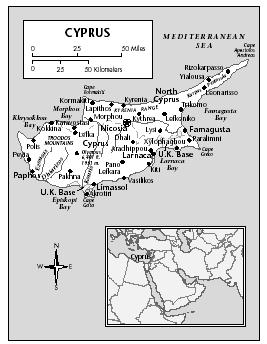Cyprus - Transportation
Internal transport is exclusively by road. In 2002, there were 10,663 km (6,626 mi) of roads in the Greek area and 2,350 km (1,460 mi) of roads in the Turkish area. In the Turkish area, 1,370 km (851 mi) of the roads were paved, compared with 6,249 km (3,883 mi) in the Greek area. In addition to numerous taxicabs, the chief towns are served by private buses, whose services are regulated by the Road Motor Transport Board. In

2000 there were 257,100 licensed private motor cars and 123,300 commercial vehicles.
Although off the main world shipping routes, Cyprus is served by passenger and cargo shipping lines. Famagusta on the east coast was the main port, but it and the ports of Kyrenia and Karavostasi were closed to national shipping after the Turkish invasion in 1974. (The port of Famagusta was reopened by the Turkish Cypriots in 1978.) The Limassol and Larnaca ports have been modernized and are now considered good deepwater harbors. Other ports include Moni, Vasiliko-Ziyyi, and Paphos. In 2002, 1,254 ships totaling 22,802,712 GRT comprised the merchant fleet, one of the world's leaders in terms of deadweight tonnage, at 36,337,768. About two-thirds of the trade passed through Limassol. There are no inland waterways.
There were 15 airports in 2001, of which 13 had paved runways. The civil airport at Nicosia was used by many international airlines until the 1974 war, after which nearly all flights were diverted to the new international airport built at Larnaca. In 1983, a new international airport opened in Paphos. In 2001, 1,503,400 passengers were carried on scheduled domestic and international flights. Cyprus Airways has services to Middle Eastern countries, but there is no regular internal air service.
Comment about this article, ask questions, or add new information about this topic: